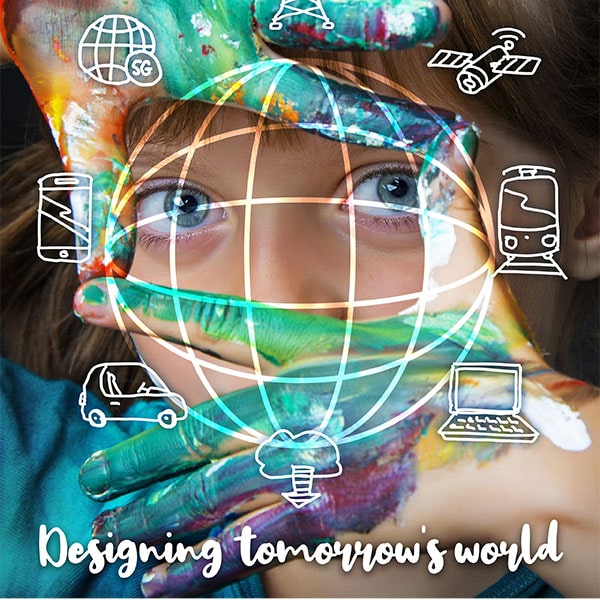Our strategy
Titled Designing tomorrow’s world, our strategy develops from our mission and values, and defines our strategic directions to fulfil an ambitious vision of ETSI’s future.
To develop our strategy, we have taken a high-level view of the main socioeconomic, policy-making and technology trends characterizing the ecosystem where ETSI operates and that may impact our activities.
We have considered a wide range of factors, including climate change, the circular economy, energy efficiency and the UN’s Sustainable Development Goals, the role of SMEs, European policy initiatives and the EC’s industrial strategy. From a more technology-driven perspective, we have also considered cutting-edge innovation in ICT, ranging from Artificial Intelligence and Machine Learning to developments in cloud, photonics and quantum computing.
In addition, we have re-examined the changing role of ICT in society manifested through digital transformation and the evolution to a data-driven society, the increasing roles of virtualization and cloud computing as well as issues related to security and privacy. Finally, we have explored the roles of the main players in the ICT ecosystem, the importance of standardization in different industry sectors, and the importance of learning, education and skills.
The successful development of Designing tomorrow’s world has been a collective exercise, depending on the contribution and consensus of all our members.
ETSI's Strategic Position
ETSI operations are underpinned by a number of basic principles that constitute its core and from which its strategy and activities stem. These principles are:
- Worldwide community
- ETSI is inclusive with a global membership representing a wide range of stakeholders, a global network of partnerships
- ETSI works across all sectors of industry and society that make, use or rely on ICT
- ETSI favours partnering, promoting global collaboration
- ETSI activities are driven by its members
- ETSI promotes the knowledge and benefits of standards
- Innovative and market driven
- ETSI works at the forefront of emerging and developing technologies
- ETSI’s work is based on timeliness, quality and responsiveness for the benefit of the market, consumers and society at large
- ETSI delivers an extensive portfolio of ICT standards with an end-to-end perspective
- ETSI produces standards aimed at being adopted by all markets, even the most competitive
- ETSI welcomes and encourages innovation contributed to all its activities, including standards, methodologies, rules and processes
- ETSI enables the availability of world class technologies for all through standardization
- ETSI promotes the visibility and availability of its standards
- Recognized European Standardization Organization with global impact
- ETSI is fully compliant with WTO TBT provisions and EU Regulations
- ETSI adopts a consensus approach in its decision making
- ETSI supports EU strategic objectives, regulatory requirements and policies
- ETSI in its standardization work strives for a sustainable future
- ETSI supports and promotes the EU Industrial Strategy objectives of becoming more green, digital and resilient
Our mission
ETSI’s mission is to provide platforms where interested parties come together and collaborate on the development and promotion of standards for Information and Communication Technology (ICT) systems and services, used globally for the benefit of all.
Our vision
Designing tomorrow’s world, ETSI is at the forefront of new Information and Communication Technology, leading the development of standards that enable a sustainable and securely connected society.
ETSI's Five Strategic Directions
ETSI aims to maintain and strengthen its strategic position through a number of Key Strategic Directions, each defining a major area of development for ETSI. Together, they define ETSI’s journey to achieve its ambitions and some of the expected major stages of that journey.
1. Being at the Heart of Digital
ETSI is at the forefront of the standardization of new and existing digital technologies and the preferred point of call for ICT related standardization. ETSI enables comprehensive end-to-end ICT architectures and technologies, including device, network and cloud.
2. Being an Enabler of Standards
ETSI provides support and a range of tools to enable the identification of the needs and requirements for standards and their production and adoption. ETSI is the enabler of standards in response to regulatory, legislative, policy and market needs
3. Being Global
ETSI creates standards intended for global use, with a membership from across the world and partnerships covering all regions and relevant sectors for ICT. ETSI tailors its processes to influence worldwide standards. ETSI builds on its ESO status to contribute to the European economy.
4. Being Versatile
ETSI innovates in its working methods, creating room for wide participation, innovation, time to deployment, and the global acceptance of its standards. ETSI may work with developer communities to support the creation and maintenance of test suites and tools and additional standard-related software material.
5. Being Inclusive
ETSI’s membership represents real market and societal needs, from local to global, leveraging the digitization of business and industry, circular economy and the sustainable development of modern society. ETSI comprises large and small companies and research organizations, as well as other business, consumer, societal and environmental stakeholders.
To learn more, read our full Strategy brochure in eBook or Download the PDF.





